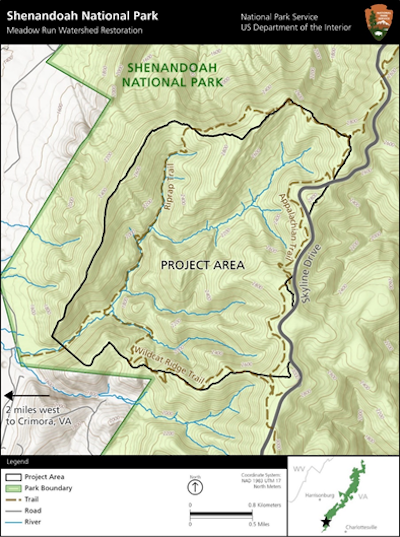
Shenandoah National Park staff want to help nature in the Meadow Run watershed recover from acid rain/NPS
Acid rain, the byproduct of air pollution, for years has led to air- and water-quality problems at Shenandoah National Park in Virginia. While air pollution has eased some, some watersheds in the park can't naturally recover from decades of acidic precipitation. So the park staff wants to step in with some help.
Currently, the park is focusing on the Meadow Run watershed in Shenandoah's south district, just to the northeast of Crimora, Virginia. According to park staff, decades of acid rain from regional air pollution has affected soil and water quality in this wilderness watershed, resulting in negative impacts to aquatic species and overall forest health.
Meadow Run is listed as pH-impaired (acid-impaired) under Section303d of the Clean Water Act. While air pollution has decreased in the last two decades, many sensitive watersheds like Meadow Run do not have the capacity to restore themselves naturally, according to staff.
The park is looking at three approaches to dealing with the problem and is seeking public comment on them. The alternatives include a no-action alternative and two action alternatives.
The no-action alternative would let natural processes continue without intervention. The two action alternatives would apply limestone sand (referred to as “liming”) across the project area to reduce the negative effects of acid rain.
Liming has proven to be an effective method for improving soil and water chemistry in other locations. It can restore terrestrial and aquatic ecosystems and has beneficial effects for plants and wildlife. Liming at this scale would be conducted by helicopter because of the large amount of limestone sand needed and because the project area is steep and remote.
Using a helicopter to perform the liming operation would be similar to wildfire response operations recently experienced within the park and may include operations off the park. Funding for this restoration is available from an air quality permit court settlement in 2016. Park staff is looking for your help in evaluating the alternatives and potential impacts of the project to improve ecosystem health in this degraded watershed.
You can learn more about the science behind the project through an interactive story map, and/or by visiting the project website. The park also has scheduled two virtual public meetings that will be held via Zoom. You can use the hyperlinks below to join the video meeting. To join by phone, dial one of the phone numbers below and enter the Webinar ID:
February 9, between 7 p.m.-09 p.m. EST
+1-833-548-0276 (Toll Free)
+1-301-715-8592
Webinar ID: 954-2008-4349
February 11, between 2 p.m.-4 p.m. EST
+1-833-548-0276 (Toll Free)
+1-301-715-8592
Webinar ID: 988-5089-9086
The Park Service is accepting public comments on the proposal through February 28. You can submit comments electronically at the project website, or submit written comments to the park’s headquarters in Luray, Virginia, by mail to:
Meadow Run Watershed Restoration Project
Superintendent Patrick Kenney
Shenandoah National Park
3655 U.S. Highway 211 East
Luray, VA 22835


 Support Essential Coverage of Essential Places
Support Essential Coverage of Essential Places







Comments
Let's note that the reason for this is the air pollution dumped on Virginia's Blue Ridge from Pennsylvania. I watched Blue Ridge visibility drop horribly from the late 1960's to present. Now, a good day is when southerly winds blow it back where it came from.